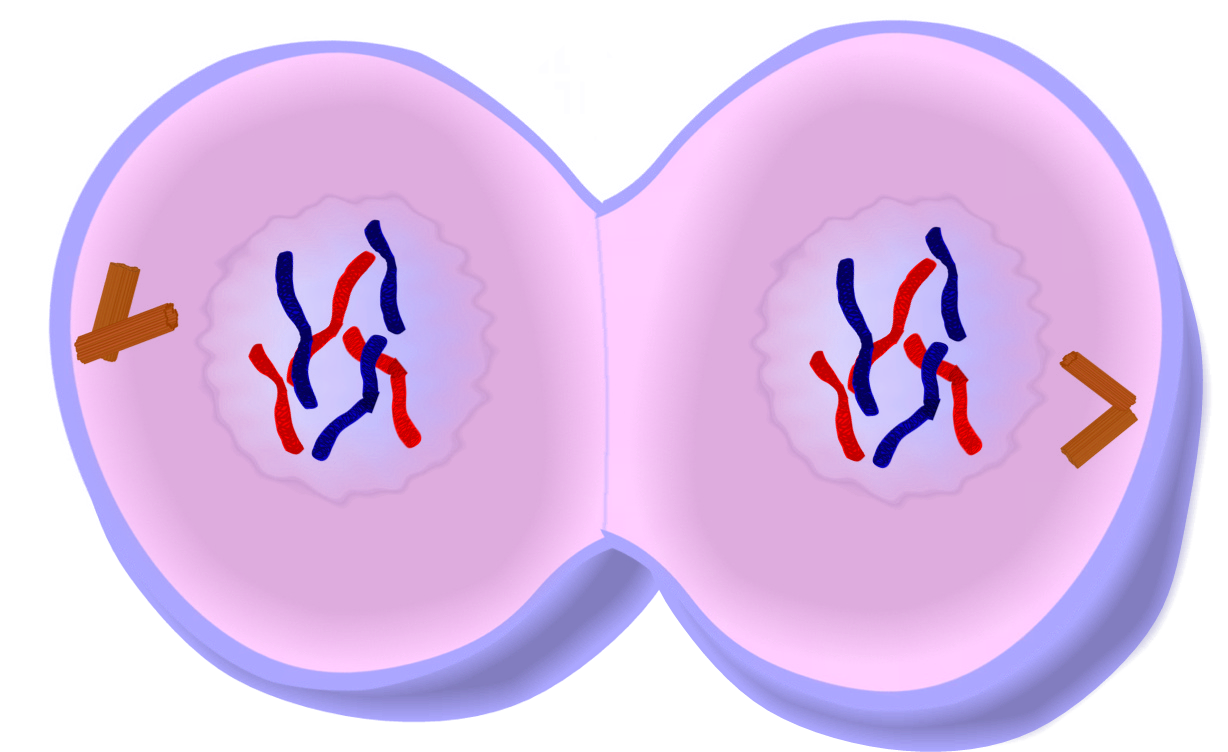

The mitotic phase is a multistep process during which the duplicated chromosomes are aligned, separated, and move into two new, identical daughter cells. The final preparations for the mitotic phase must be completed before the cell is able to enter the first stage of mitosis. There may be additional cell growth during G 2. Some cell organelles are duplicated, and the cytoskeleton is dismantled to provide resources for the mitotic phase. In the G 2 phase, the cell replenishes its energy stores and synthesizes proteins necessary for chromosome manipulation and movement. We should note, however, that centrioles are not present in the centrosomes of other eukaryotic organisms, such as plants and most fungi. For example, roughly at the center of each animal cell, the centrosomes are associated with a pair of rod-like objects, the centrioles, which are positioned at right angles to each other. The two centrosomes will give rise to the mitotic spindle, the apparatus that orchestrates the movement of chromosomes during mitosis. The centrosome is also duplicated during the S phase. In the S phase, DNA replication can proceed through the mechanisms that result in the formation of identical pairs of DNA molecules-sister chromatids-that are firmly attached at the centromeric region. Throughout interphase, nuclear DNA remains in a semi-condensed chromatin configuration. The cell is accumulating the building blocks of chromosomal DNA and the associated proteins as well as accumulating sufficient energy reserves to complete the task of replicating each chromosome in the nucleus. However, during the G 1 stage, the cell is quite active at the biochemical level. The first stage of interphase is called the G 1 phase (first gap) because, from a microscopic point of view, little change is visible. The three stages of interphase are called G 1, S, and G 2. In order for a cell to move from interphase into the mitotic phase, many internal and external conditions must be met. Interphaseĭuring interphase, the cell undergoes normal growth processes while also preparing for cell division. Following mitosis, the cytoplasm is usually divided as well by cytokinesis, resulting in two genetically identical daughter cells. During the mitotic phase, the duplicated chromosomes are segregated and distributed into daughter nuclei. Interphase is followed by the mitotic phase. During interphase, the cell grows and the nuclear DNA is duplicated. We should note, however, that interphase and mitosis (karyokinesis) may take place without cytokinesis, in which case cells with multiple nuclei (multinucleate cells) are produced.įigure 10.5 The cell cycle in multicellular organisms consists of interphase and the mitotic phase. During the mitotic phase, the replicated DNA and cytoplasmic contents are separated, and the cell cytoplasm is typically partitioned by a third process of the cell cycle called cytokinesis. During interphase, the cell grows and DNA is replicated. The cell cycle has two major phases: interphase and the mitotic phase ( Figure 10.5).
#PROPHASE PROMETAPHASE METAPHASE ANAPHASE TELOPHASE SERIES#
Cells on the path to cell division proceed through a series of precisely timed and carefully regulated stages of growth, DNA replication, and nuclear and cytoplasmic division that ultimately produces two identical (clone) cells.

The cell cycle is an ordered series of events involving cell growth and cell division that produces two new daughter cells.


 0 kommentar(er)
0 kommentar(er)
